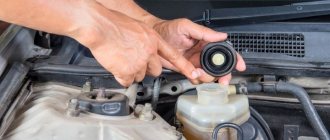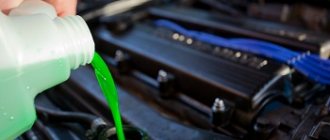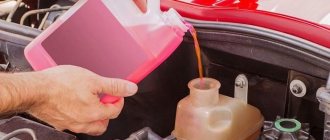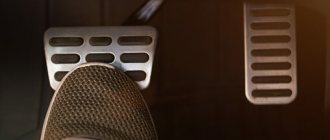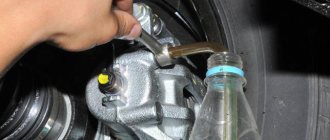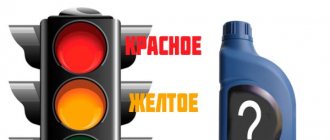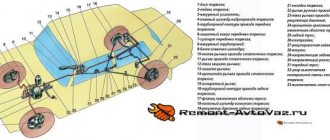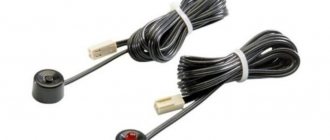Hello again, friends, today I will share useful information about mixing brake fluids. Often you don’t know or don’t remember what kind of fluid was poured into the brake reservoir. And the time has come to top up or change it. If it's time for you to change the fluid, read my article on replacing brake fluid yourself.
But this article will help you top it up correctly. Is it possible to mix brake fluid when adding brake fluid to the reservoir when there is not enough old? What will happen? What are the dangers of mixing? Which ones are allowed to be mixed? Is it worth listening to the advice of the “crazy people”, “Kulibins” and other craftsmen to spoil their own and other people’s cars? I'll tell you now.
What are there
I'll start with the types (varieties) of brake fluids, there are not so many of them, but still should not be confused:
- I also found BSK - it was used in old GAZ cars, it cannot be mixed with anything.
- Later, when the DOT brand appeared, DOT-1 and 2 were popular at first. They were produced on a mineral base, now they are not produced or used, they could only be mixed with each other, not with others.
- Today, DOT-3,4,5.1, which are glycol-based, are relevant in use, which allows them to be mixed with each other, but is not always recommended.
- They should not be confused with DOT-5 and 5.1ABS; these fluids are different, silicone-based and work on racing cars and sports cars where increased braking performance is required.
How often should you change brake fluid?
It is recommended to change the TZ at least once every two years, regardless of the car model, since it operates under difficult operating conditions - it heats up to high temperatures with frequent braking. “Brake fluid” is also hygroscopic, and over time moisture accumulates in its composition, which reduces the boiling point of the fluid. If too much moisture accumulates, the fluid will boil when braking, and the car’s brakes will fail.
You should also change the brake fluid:
- when buying a used car - it is not known when the previous owner last serviced the vehicle;
- when the liquid becomes cloudy or sediment appears in it.
The industry has developed special testers that check the hygroscopicity of fuel fluid; an example is the Novitec device. There are four indicators on its front panel:
When the green Gut indicator lights up on the tester when checking the brake fluid, this means that the brake fluid meets the requirement of hygroscopicity and does not contain water in its composition. 1% - the condition of the brake fluid is satisfactory, 2 and 3% - the fluid needs to be changed, it is not suitable for further use.
Characteristics
There is no point in taking the characteristics of substances that are not used, so for comparison I will give those that you will still find on sale.
| Type | Color | Boiling point | |
| New | With humidity 3.5% | ||
| DOT-3 | Transparent, yellow and to brown | 205 | 140 |
| DOT-4 | Transparent, yellow and to brown | 230 | 155 |
| DOT-5.1 | Transparent, yellow and to brown | 260 | 180 |
| DOT-5/5.1 ABS | Pink to dark red | 260 | 180 |
Initially, they do not contain moisture, but they collect this moisture from the air, therefore, after a few years, the characteristics are greatly reduced, already at a humidity of 3.5%, the boiling point drops by 1.5-2 times. Therefore, store them only in hermetically sealed containers, and the tank must be constantly closed with a lid and not have cracks or holes to prevent air from entering.
The same reason - the accumulation of moisture in the brake fluid, requires periodic replacement of all the fluid inside the system.
How to Check Brake Fluid Condition Using a Handheld Tester
Using a tester, it’s very easy to check TF for hygroscopicity; to check, in addition to the device itself, you will also need a clean container (jar or glass) and a medical syringe:
- unscrew the cap of the brake system reservoir, take out a small amount of fuel fluid with a syringe;
- pour the liquid into a glass;
- lower the tester probe into the container with fuel fluid, press the device power button;
- We look at the indicators - in this case, all the LEDs lit up, including the 3% indicator. This indicates that the brake fluid contains at least 3% water, so the fluid must be changed.
For comparison, we check the condition of fresh, unused TJ and pour it into another clean glass. Only one green LED “Gut” lights up on the device - this liquid does not contain moisture.
Which one to use?
Many car enthusiasts have a question about what fluid to use, especially those who recently bought a car and received a license. It is recommended to use the specification specified in the manual supplied with the machine. If you have lost your manual, it is now easy to look up the data online.
What should I do if I don’t have the fluid listed in the manual? There are such cases. You need to know which of them are compatible with each other. Let’s say you need DOT-3, you can safely add or replace it with the highest class 4 or 5.1, but only on the same base that allows mixing. Another option is to look at its analogs (ours or imported ones) on the Internet, or ask experts who have encountered this.
For example, using silicone brake fluids when you are prescribed glycolic brake fluids is suicide. Why can’t I use different brands of substances? It’s just that all rubber bands and mechanisms, cuffs, are designed for this type of chemicals; using a different type will cause destruction of the cuffs and seals, leakage and failure of the braking system.
Mixing brake fluid based on silicone and glycol is also prohibited; the difference in composition can cause coagulation and clogging of the system, and this also means brake failure. Serviceable brakes save lives, (and not only yours) remember this.
The use of a lower class of fuel fluid (the third pillbox instead of the fifth, for example), with a reduced boiling point is not desirable, because the calipers heat up, sometimes very much, and if the composition boils, the brake pedal will fail and the car will not stop in a timely manner.
Are pillbox substances from different manufacturers compatible? Yes, they are compatible, the fact is that the DOT marking means a production and composition standard. That is, in fact, manufacturers produce the same substances, according to the standard, provided that it is not a fake.
Interchangeability of different brands
Recommendation one: topping up brake fluid made on a different base is unacceptable and dangerous to the lives of vehicle passengers. That is, silicone or BSA cannot be added to the glycol composition and vice versa.
What is the danger: the consequences do not appear immediately, but after some time, until the material is mixed and heated as a result of the brakes being applied. A precipitate forms in the mixture and dense clots form, blocking the normal operation of the system - the brakes fail. In the best case, you will have to empty all the cylinders and pipes for thorough washing.
Russian analogues
Let's look at the Russian analogues for Neva and Tom brakes, and whether they can be mixed with each other and with derivatives of the DOT classification:
- Neva, familiar to many, is produced on the basis of glycol with polyester. It also contains an anti-rust additive. However, the disadvantage is the rapid accumulation of water in it (hygroscopicity), which reduces its characteristics and requires more frequent replacements than others, is considered obsolete, and is gradually going out of production.
- Tom liquid contains glycol ether and a set of additives. Its performance is higher than that of Neva. In terms of quality and composition, it meets the DOT-3 class.
- The same base allows you to mix them with each other, replace the Neva with Tom. In addition, Tom can be mixed with other liquids of the dot-3 class and higher that have a glycol base.
- But can Neva be mixed with Dot 4? It is possible, this has been tested by experience and in practice by many motorists. Only this mixture, due to the fault of the Neva, requires more frequent changes, reducing the time by almost half. Agree, it will be cheaper to completely replace the Neva with a more reliable and long-term analogue.
Dry and wet mixture
At the very beginning, I would like to talk about the hygroscopicity of brake fluid (for those who don’t know, this is the ability to absorb moisture from the environment). That is why it must be changed after a certain period of time, on average every 2 - 4 years, it all depends on the class (more on this below).
So, when you have just opened a sealed jar (which has not had contact with the surrounding air), and want to pour it into the main tank, then this composition will be called DRY , because there is no moisture there at all! After all, it just opened.
But if your car or open can was in contact with air (the can may have been lying open on a shelf for a couple of years). The liquid has already absorbed a large percentage of moisture! Moreover, only 3.5% is enough so that it can no longer be used in the braking system! This mixture is called MOISTURIZED (it simply contains water)!
Recommendations
Experienced drivers prefer to change the fluid rather than top it up. As a rule, its volumes inside the tank should increase. This happens due to moisture getting into it. If the level of dot 4 (and other fuel fluid) decreases, this is a sign of a leak; before adding, you need to find the leak and fix it.
But here are some tips like: it’s a drag – it’s a drag in Africa too, pour any kind, it’s okay – this is advice from suicides, and for suicides. Even “thank you” for such advice may not work - no one returned from there.
A leak is dangerous because air gets inside the system, which leads to brake failure at the most undesirable moment. So topping up is a last resort measure; it is better to eliminate the leak with a complete fluid replacement and bleeding of the entire system.
Beware of fakes! Which are now everywhere, everywhere and in all industries. Because it's money, it's cheap, it's profitable for scammers. You should not buy something “cheaper”, incomprehensible (unknown brand), and in non-branded stores. You should not take it where it is sold not in bottles, but bottled into your container from barrels! Purchased from dealers, in branded stalls and packages, although somewhat more expensive, but with a guarantee of quality. Moreover, this is not gasoline; you do not need to purchase them often.
I hope now you understand why some liquids cannot be mixed with others, and which ones are allowed to be mixed. This is the key to your safety. The law of meanness comes into play for those who neglect safety - they just forgot to check the brakes - there's a car in front of you, or a person is running across the road! This is not something to joke about. That’s all I have, subscribe to updates, those who haven’t done so, share with your friends, it will also be useful for them to know, and see you later.
Dry and wet mixture
At the very beginning, I would like to talk about the hygroscopicity of brake fluid (for those who don’t know, this is the ability to absorb moisture from the environment). That is why it must be changed after a certain period of time, on average every 2 - 4 years, it all depends on the class (more on this below).
So, when you have just opened a sealed jar (which has not had contact with the surrounding air), and want to pour it into the main tank, then this composition will be called DRY , because there is no moisture there at all! After all, it just opened.
But if your car or open can was in contact with air (the can may have been lying open on a shelf for a couple of years). The liquid has already absorbed a large percentage of moisture! Moreover, only 3.5% is enough so that it can no longer be used in the braking system! This mixture is called MOISTURIZED (it simply contains water)!
Additives overview
Brake fluid contains several additives. The main ones are discussed in the table below.
Table - Brief overview of the main brake fluid additives
AdditiveNote
| Dye | Helps determine brake fluid class |
| Anti-corrosion additive | Reduces damage to metal surfaces of the brake circuit |
| Antioxidant reagents | Inhibits the breakdown of constituent components and reduces the formation of acids and resins |
| Diphenylolpropane, bisphenol, triazole, azimidobenzene | Extends brake fluid service life |
Tips for choosing
To choose the right brake fluid for your car, you should pay attention to its physical parameters, which will prove its high quality. First of all, the concentration of the solvent is important. In a good liquid it should range between 70-80%. Another important factor is the concentration of the lubricant, which is usually 20-25%.
It is also worth paying attention to:
- heat resistance - the higher the boiling point of the liquid, the better;
- kinetic viscosity - determines the resistance to fluid flow in a hydraulic system;
- hygroscopicity - the ability to dissolve water molecules that can damage the brake system;
- inhibitor concentration is a group of additional substances that provide protection against corrosion and oxidation of the liquid.
Reviews
I only buy Neva. It hasn't darkened in a year, although all sorts of dust gets into the tank. Good ductility and color.
I have been using only Neva for ten years. And not only in the brake system, but also in the clutch system. No problems, everything works great. The liquid is oily, yellow, and can withstand temperature changes well. I recommend!
Don't go after what's expensive. I buy a cheap Neva, I still have to replace it in two years. The brakes work great, what's the point in being expensive?
The characteristics of the Neva brake fluid are normal. I am an experienced driver, I can judge. Hygroscopicity fails, it must be changed after a year and a half.
I figured out that Neva is an excellent brake fluid. The brakes are tight and reliable, and this is the most important thing in a car.
So what if?
But what happens if you still mix, for example, old BSK with modern DOT-3 and -4? First of all, the rubber cuffs will suffer: being already wetted with mineral fluid, they will swell upon contact with DOT glycols - and sooner or later the hydraulics will fail. The hoses will also suffer, and this can lead to no less trouble - even jamming the brakes. Against this background, the “curdling” of castor oil – the mineral basis of BSC – will seem like an annoying trifle.
If the system contains both BSK mineral fluid and any of the glycol DOTs, the rubber parts of the hydraulic drive will most likely fail.
Recommendations “Auto 24”
Most fluids used in modern cars can be mixed without catastrophic consequences. You only need to be seriously wary of the outdated composition of BSK and the super-advanced DOT-5 (without additional indices). Find out in advance if these exotic varieties are used in your car for an hour in order to avoid troubles with possible subsequent topping up. But even if you have one of the common DOTs in your system, be prepared for the fact that some car models will not accept the foreign mix (for example, due to problems with ABS) and you will have to drive slowly to the nearest service station. Therefore, the most reasonable thing is to keep a logbook where you record all the data on consumables that are used in the car during its maintenance and repairs. And on a more global level, it is important to maintain the machine in a condition where it does not require topping up, but only a scheduled replacement of working fluids.
What is TJ used for?
The task of any diesel fuel in every car is to have the lowest compression ratio and calmly withstand maximum temperatures, in other words, not to start boiling at high temperatures. On average, a car can work on one vehicle for about 3 years - everything depends on the quality of this mixture, as well as on the weather outside and on general performance characteristics.
But still, sometimes every car needs to replace the brake mixture, and this may be required not only because of its deterioration in terms of performance. The need for replacement is usually caused by a break or break in the brake wire (hose), which, naturally, can go along with the leakage of the mixture. It is dangerous if this happens while the car is moving.
However, you can always go to a car dealership, but what if they do not stock the type of brake mixture that is used in your car? This raises a completely reasonable question: isn’t it dangerous to mix brake mixtures for cars from different brands or different classes? I tried my best to understand this article.
Like all the main elements of a car, it has come a long way in its development. Manufacturers experimented and came up with the ideal formula, adding various additives to TJ in order to improve their products to the level that we can see today.
At the initial stage of its development, the brake mixture had a primitive composition - mineral additives were used as its basis. After a certain period of time, manufacturing companies concluded that glycol should be the basis of TK (due to poor absorption), after which they began to use ordinary silicone as a basis. Currently, the most common types of liquids are glycol mixtures and silicone type mixtures.
Security measures
To prevent brake fluid from oxidizing, evaporating, or picking up moisture, it must be stored in an airtight container.
As a rule, they are flammable, so they must be kept away from open flames and high temperatures.
They are poisonous, it is recommended to work with gloves, although there will be no obvious signs of burns if they come into contact with the skin.
Under no circumstances should you drink, even a small amount will lead to poisoning. If liquid gets into your eyes, rinse them thoroughly with clean water and consult a doctor.
Sound insulation of doors on the Lada Granta Possible malfunctions of the suspension of the Lada Granta Thermostat of the Lada Granta Generator of the Lada Granta Removing and installing the radiator grille on the Lada Granta Removing the bumper on the Lada Granta
Classification
There are several systems for dividing brake fluids: according to viscosity, according to DOT standards, boiling point. In addition, there are generally accepted standards - SAE J 1703, ISO 4925, etc.
The most common of them is gradation according to DOT standards, it consists of:
DOT3 (glycolic)
Recommended for classic cars with front brakes and rear drums.
Main characteristics:
- the boiling point in the “dry” state is not less than 205 degrees, in the “moistened” state (contains 3.5% water) - not less than 140 degrees;
- viscosity at negative temperatures (-40 degrees) – not less than 1500 mm2/s.
DOT4 (glycolic)
Used for modern vehicles with disc brakes on both axles.
Main characteristics:
- the boiling point in the “dry” state is not less than 230 degrees, in the “moistened” state (contains 3.5% water) - not less than 155 degrees;
- viscosity at negative temperatures (-40 degrees) – not less than 1800 mm2/s.
DOT5 (silicone) and DOT5.1 (glycolic)
It is used on sports cars with a fairly high temperature load.
Main characteristics:
- the boiling point in the “dry” state is not less than 260 degrees, in the “moistened” state (contains 3.5% water) - not less than 180 degrees;
- viscosity at negative temperatures (-40 degrees) – not less than 900 mm2/s.
Types of bicycle brakes
- disc (mechanical or hydraulic brakes);
- rim (V-breaks and U-breaks, pincer brakes, and in addition, cantilever brakes);
- pedal or otherwise drum (sleeve);
- stirrup;
- roller (also bushing).
The following bicycle models are equipped with rear hub brakes (drum, roller):
- urban single-speed;
- children's;
- folding.
And on mountain, road, hybrid and touring bikes, as well as on the front wheels of city and folding bikes, rim brakes are installed.
When it comes to disc brakes in various configurations, they are a literal necessity where superior cycling performance is required.
Why is it necessary?
Hydraulic brakes are very dependent on the fluid used. Its main task in such a system is to transmit force from the pressed handle to the pistons in the caliper through the master cylinder.
An important property of the “brake guard” is that it practically does not compress under load. Due to this, the composition does not absorb mechanical force, but transfers it to other elements. Additionally, the fluid must withstand high temperatures well, since natural heating occurs under the influence of friction during braking.
Mixing products from different brands
When producing working compounds for automobile brakes, manufacturing plants must strictly adhere to uniform standards and comply with technical specifications. Hence the conclusion: you can mix brake fluid from different manufacturers if “native” is not available for sale. The main thing is to follow the above rules regarding diluting silicone with glycol and vice versa. Only mixing materials on different bases gives a negative result; the brand does not matter.
If the system urgently needs to be replenished on the road, and the product from the required manufacturer is not available in the store, choose a liquid from another brand on a similar basis. Lower cost is not always an indicator of low quality, so you can buy a cheaper option. If doubts begin to torment you, you will change them after returning home.
The possibility of mixing is also limited by the class of passenger vehicle. As a rule, liquids of various brands and manufacturers (but not of different chemical compositions) can be filled into budget cars without problems. The requirements for premium cars, heavy modern SUVs and sports cars are more stringent. Accordingly, the operating instructions limit the use of brake fluid to one brand, for example, DOT 5.1/ABS.
If you have just such a car, then adding another brand of fluid in case of leakage is not allowed. Theoretically, instead of 5.1/ABS, you can try to top up the fifth series silicone, get to the garage and immediately empty the system without waiting for the consequences. What such a decision will lead to in practice depends on the specific car model. It is likely that nothing bad will happen and only after 2-3 years will a car service technician changing the rubber seals in the calipers discover traces of exposure to the “wrong” fluid.
